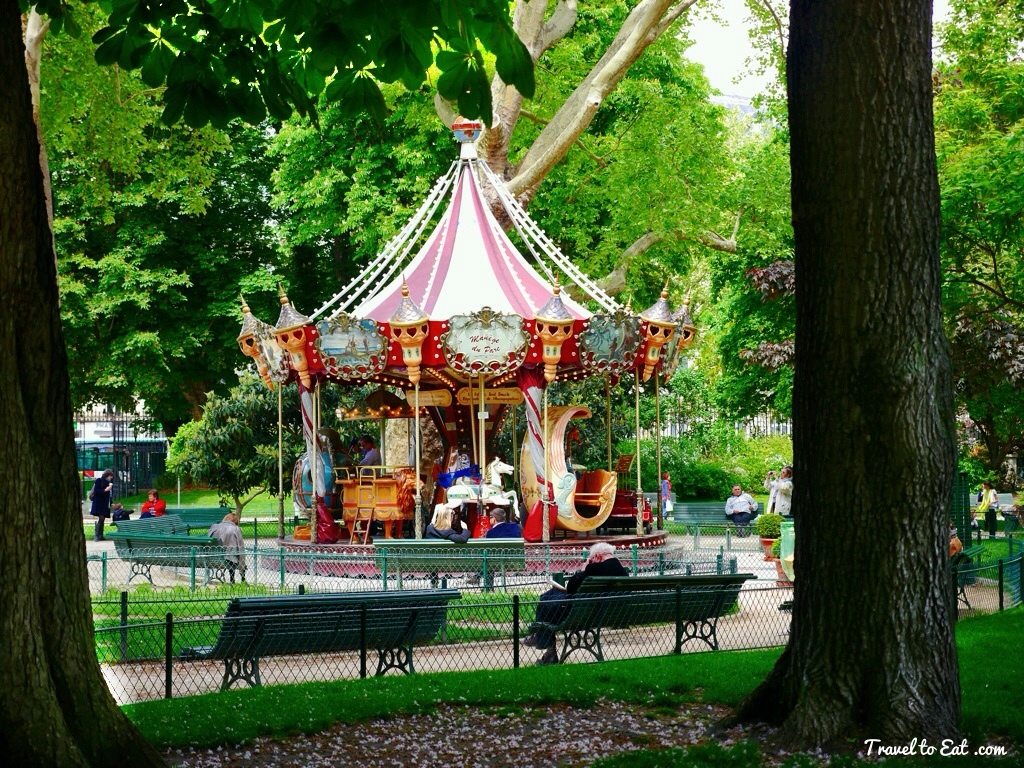
Much of Parc Monceau is ringed with 18th- and 19th-century mansions, some evoking Proust's Remembrance of Things Past especially since he frequently wandered here. Louis Carrogis Carmontelle designed it in 1778 as a private hideaway for the duc d'Orléans (who came to be known as Philippe-Egalité), at the time the richest man in France. The Duke was a close friend of the Prince of Wales, later George IV, and a lover of all things English. His intention was to create what was then called an Anglo-Chinese or English garden, on the earlier model of Stowe House in England (1730–1738), with its examples of the architectural folly, or fantastic reconstructions of buildings of different ages and continents. It was similar in style to several other examples of the French landscape gardens built at about the same time, including the Desert de Retz, the gardens of the Château de Bagatelle and the Folie Saint James.



As garden fashions changed, in 1781 parts of the park were remodeled into a more traditional English landscape style by the Scottish landscape gardener Thomas Blaikie known for his work at Bagatelle (see my post). In 1787, a new city wall, the Wall of the Farmers-General, was built along the northern edge of the garden, along with a circular rotunda in the form of a classical Doric temple, known as the Pavilion de Chartres, designed by Claude Nicolas Ledoux. The ground floor of the temple was used as a customs house, while the upper floor was an apartment with a view of the garden reserved for the Duke. The pavillon de Chartres was modified by the architect, Gabriel Davioud in 1861, who had a graceful classical dome added to the structure.




After the monarchy was restored, the park was restored to the family of the Duke. During the Second Empire, the family sold lots within the park to real estate developers, who built luxurious town houses, reducing the size of the park by half. The remaining part of the park was purchased by the city of Paris in 1860. All that remained of the original folly was the water lily pond, the stream and the fantasy “tombs,” including the Egyptian pyramid.

When we got to the colonnaded water lily pond, the famous Naumachie, a basin surrounded by Corinthian columns, some boys were playing Mölkky, a Finnish throwing game invented by the Tuoterengas company in 1996. The players use a wooden pin (also called “mölkky”) to try and knock over wooden pins (also called “skittles”) of almost similar dimensions with the throwing pin, which are marked with numbers from 1 to 12. The first one to reach exactly 50 points wins the game. Scoring more than 50 will be penalised by setting the player's score back to 25 points. We watched for a while, it looked like fun.


The pond was full of ducks including this handsome tan little fellow and a group napping on the island in the center. The park is also the green space in the borough which contains the greatest diversity of birds. They are attracted by the height of trees and the freshness of the basin, crisscrossed by large carp and smaller goldfish. If you go in May, you will witness the charming spectacle of mallards escorted their young chicks.


In 1852 the park was purchased by the city, and in August 1861 Parc Monceau became the first new public park in Paris to be remade by Baron Haussmann as part of the grand transformation of Paris begun by Emperor Louis Napoleon. The design of the park was changed one last time by the engineer Jean-Charles Alphand, the architect and horticulturist Jean-Pierre Barillet-Deschamps, who worked under the orders of Baron Haussmann. In 1861, Napoleon III was finally able to inaugurate the park we know today. Two main alleys were laid out from east to west and north to south, meeting in the center of the park, and the alleys within the park were widened and paved, so carriages could drive the park.


Gabriel Davioud also built a bridge modeled after the Rialto bridge in Venice over the stream to replace the Chinese bridge that Carmontelle had once been there. He preserved the other follies remaining from the original garden.





There are the massive antlers of a purple maple “on elephant skin” thriving amidst a multitude of other trees (Corsican pine, hackberry Provence, Paulownia, silver linden, honey locust tree of Judea, tulip tree, tree with pockets) small shrubs and ever-changing floral baskets.

The park is unusual in France due to its “English” style, its informal layout, curved walkways and randomly placed statues distinguish it from the more traditional, French-style garden. It includes a collection of scaled-down architectural features, or follies, including an Egyptian pyramid, a Chinese fort, a Dutch windmill, and Corinthian pillars. A number of these are masonic references, reflecting the fact that Philippe d'Orléans was a leading freemason. Parc Monceau also includes statues of famous French figures including Guy de Maupassant, Frédéric Chopin, Charles Gounod, Ambroise Thomas, Alfred de Musset, and Edouard Pailleron.

Jean-Antoine-Gabriel Davioud designed the wrought-iron grillwork for the fences. This exit leads out to Avenue Hoche which is only about two long city blocks to the Arc de Triomphe. If you find yourself in Paris on the Champs Élysées, consider a relaxing break at the Parc Monceau. This is a beautiful garden, less crowded than the Luxembourg or Trocadéro and a great place for a picnic.
References:
Parks and Gardens Paris: http://parcsetjardins.equipement.paris.fr/
Monceau: http://equipement.paris.fr/parc-monceau-1804

